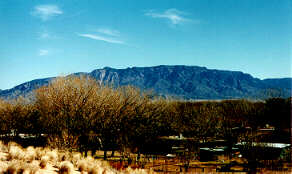 A
sustainable city protects and is nurtured by its natural resources, social fabric,
and financial resources. Community vision, commitment, and political courage are
required to reject damaging, short-term solutions in favor of actions that will
move a city toward sustainability.
A
sustainable city protects and is nurtured by its natural resources, social fabric,
and financial resources. Community vision, commitment, and political courage are
required to reject damaging, short-term solutions in favor of actions that will
move a city toward sustainability.
Albuquerque's Comprehensive Plan policies and Five-Year Goals And One-Year Objectives establish direction for sustaining the needs of the city's population into the future. The Shared Vision, Inc. Program provides a forum for continuing the citizen dialogue necessary for keeping city goals and programs responsive to the needs of Albuquerque's citizenry.
Albuquerque's growth policy studies, fiscal impact analyses, and other works in progress examine how city policies and development affect our sustainability. A community-based planning program, the Groundwater Protection Policy and Action Plan, regional multimodal transportation planning, and Albuquerque's Water Conservation Program are some other important efforts.
Policies in the 1975 and 1988 versions of the Albuquerque/Bernalillo County Comprehensive Plan and more detailed area and sector plans have helped Albuquerque maintain most of its magnificent views of the mountains and western escarpment.
For example, the Coors Corridor Plan and the Northwest Mesa Escarpment Plan contain building height requirements for view preservation. A 10% slope demarcation line in the Sandia Foothills Area Plan and public Open Space land purchases have prevented urban development on most of the Sandia Mountain foothills. The volcanoes, volcanic escarpment, and other distinguishing natural features and wildlife areas in and around the city have been similarly protected.
The City Open Space Management Plan and subsequent projects have developed the Rio Grande bosque as a nature preserve and recreational corridor for extensive but responsible and ecologically sound use.
Sometimes facility and corridor plans and public projects developed for single purposes (e.g., drainage or vehicular transportation) fail to conform to Comprehensive Plan policies. Albuquerque's low-density zoning and resulting suburban land-use pattern create increased traffic volume and miles traveled and therefore cause pollution. As a result, distinguishing natural features are compromised and natural resources are wasted. Perhaps stronger growth policies and better inter-agency coordination will eliminate these problems in the future.
Albuquerque has a diverse ethnic, racial, social, economic, and religious population mixture, giving the community a natural heterogeneity. The Shared Vision forums and Albuquerque's Cultural Plan process brought many people together to examine the threads of Albuquerque's social fabric.
V. B. Price's introduction to the Cultural Plan for Albuquerque says, "Our cultural environment is radically outside the mainstream, and yet it brings to the mainstream something superbly and brilliantly American--a defiant sense of creative and cultural self-sufficiency." He also says that the plan "ably promotes the diversity and quality of our hidden cultural life to outsiders and to our own ever-increasing population."
Albuquerque's suburban form coupled with insufficient attention to landmarks, historic resources and history has led to several problems that contribute to the breakdown of social fabric:
Perhaps the Community-Based Planning Program in conjunction with clear growth policies will more clearly direct our physical size, shape and spending priorities and firmly anchor our sense of place and sense of ourselves as a community.
If city public service systems and facilities are built under sustainable growth policies, then reasonable amounts of tax revenue and periodic revenue bonds are sufficient to operate, maintain, and rehabilitate them.
Sufficiently concentrated land uses can provide a critical mass of people to support mass transit, walkways, and bikeways. Linear distances of roadways, drainage facilities, water, sewer, and power lines are minimized to hold down installation, operating, maintenance, and rehabilitation costs. And optimum economies of scale are achieved for parks, schools, and other public facilities.
Local wealth is circulated back into the community rather than exported to pay for imported energy resources for cars, heating, and cooling.
In sustainable communities, education is excellent, abundant, and accessible for all children and adults. Well-paying jobs keep home-grown talent in the local work force. Strong, diversified employment that does not deplete or harm our local resources generates a good tax base to fund community endeavors and promotes opportunities for more employment. Housing is affordable and good health care is accessible.
Albuquerque's Fiscal Impact Model estimates the cost and revenue streams from proposed large developments and land-use changes. This and other information should help Albuquerque choose projects that will fiscally sustain our community.
It will require everyone's cooperation and commitment to plan for the Albuquerque of tomorrow. If we are to protect, preserve, and enhance our quality of life, we all must become informed and willing to participate by sharing our ideas, goals, and dreams. Sharing and caring will shape our future.
(Up to Section V, Back to Section IV Bibliography, On to Air Quality)